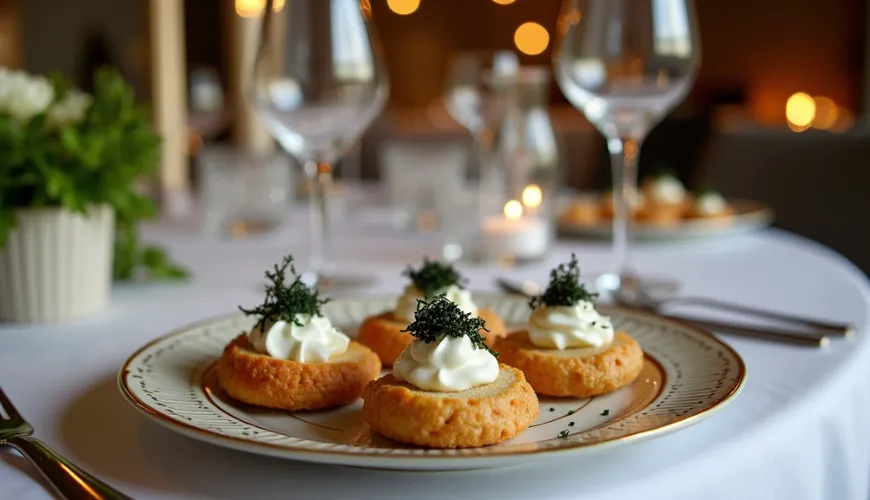
Discover the Magic of Blinis and Their Place in Modern Cuisine

Bliny - A Traditional Dish That Tastes Through the Centuries
Bliny, sometimes incorrectly mistaken for pancakes, are an exceptionally rich and symbolic dish that holds a special place in Russian cuisine. Although they might initially seem like ordinary pancakes, they embody history, festive value, and cultural significance. Recently, bliny have been gaining popularity outside their country of origin, not only among lovers of unconventional cuisine but also among those interested in slow cooking, honest ingredients, and a return to traditions.
This is why recipes for Russian bliny are increasingly sought after—whether you desire an authentic experience from a Russian household or want to spice up a festive table with something extraordinary. And if the word "bliny" summons images of caviar, you're not alone. Bliny with caviar are one of the most luxurious variations of this dish, traditionally served in Russia during Maslenitsa—a festival bidding farewell to winter.
What Exactly Are Bliny?
Unlike French crepes or Czech pancakes, bliny have a specific texture and taste that make them truly unique. Traditional Russian bliny are made from a yeast dough based on buckwheat or wheat flour, often with a portion of milk, kefir, or even sour cream. The result is a delicate yet moist dough with a slightly sour taste, which, when baked, transforms into golden, fluffy pancakes. These are served warm, brushed with butter, filled with various fillings, or served savory—most commonly with caviar, sour cream, or smoked salmon.
But bliny are more than just food—they are a symbol of hospitality, abundance, and the sun. According to ancient Slavic traditions, the round, golden bliny had the shape and color of the sun and were prepared during the time when its return was celebrated—during the weeklong festival of Maslenitsa, preceding the Orthodox Lent.
Recipe for Traditional Russian Bliny
The key is patience. If you want to prepare real bliny according to a Russian recipe, arm yourself with time—the dough needs to rise, and proper preparation will take several hours. But once you taste the result, you'll know it was worth it.
Ingredients:
- 500 ml warm milk
- 20 g fresh yeast (or half a packet of dry yeast)
- 1 teaspoon sugar
- 1 egg
- 200 g plain flour (ideally wheat, part can be replaced with buckwheat)
- a pinch of salt
- 2 tablespoons melted butter
- oil or butter for frying
The method is simple, but requires care. First, a starter is made from the yeast, a bit of sugar, and part of the milk. When it starts to froth, the rest of the ingredients are mixed in, and the dough is left covered to rise—ideally in a warm place for at least an hour. The resulting dough should be thick but still liquid, similar to pancake batter. On a pan, small, round pancakes are then fried until golden.
Serving is a chapter of its own. Besides the classic bliny with caviar and sour cream, there are countless variations—sweet with blueberries, honey, or jam, savory with fish, mushrooms, or meat. The possibilities are endless.
Bliny as a Festive Dish
In Russia, bliny are primarily associated with the Maslenitsa festival, which is similar to our carnival. Throughout the week, they are baked in every household, in large quantities. People bring them to neighbors, friends, and host bliny feasts and competitions. It is a time of joy, merriment, and communal eating meant to connect people and prepare them for the upcoming fast.
But bliny are not just a seasonal affair. In many Russian households, they are regularly prepared—as a Saturday breakfast, a festive appetizer, or part of the spread for significant occasions. Because of this, bliny recipes have started spreading outside Russia and have become popular across Europe and America.
Today, we can also encounter them in a modern guise—served on a wooden board with microgreens and vegan caviar, prepared gluten-free or with plant-based milk. However, despite these innovations, they retain their essence—they are simple, honest, and festive at the same time.
Bliny with Caviar
One of the most iconic variations is precisely bliny with caviar. Traditionally, black or red caviar (most commonly salmon) is used, served on a hot blin along with a spoonful of sour cream and a sprig of dill. The result is a combination of delicate dough, salty delicate taste, and creaminess that satisfies even the most demanding palates.
In luxury restaurants, such bliny are often served as an appetizer at festive feasts, weddings, or Christmas dinners. But this doesn't have to be an unattainable delicacy. Even at home, you can prepare simple bliny with caviar, all it takes is quality ingredients: fresh butter, honest sour cream, and fresh or pasteurized caviar according to your possibilities.
Families who have tried this combination often return to it as an exceptional dish for special occasions. And even when caviar is replaced with smoked trout or a vegan alternative.
How to Incorporate Bliny into Modern Cuisine?
To some, it might seem that traditional dishes like bliny have no place in modern menus. However, the opposite is true. Their versatility and simplicity make them destined to become part of everyday and festive cuisine. Bliny recipes can easily be adapted to current dietary habits—using gluten-free flour, plant-based milk alternatives, or preparing them in a sweet version with fresh fruit.
For example, in one Czech family trying to focus on seasonal and local eating, bliny have become part of weekend breakfasts. Instead of caviar, they use fresh cottage cheese with chives or homemade apple puree. And that's their magic—they adapt to every kitchen and every occasion.
As Russian writer Lyudmila Ulitskaya said: "Bliny are not just food. They are memories, sharing, warmth, and home."
Thus, bliny are not just a culinary creation. They are a bridge between the past and the present, between tradition and innovation. Whether you prepare them according to an authentic Russian recipe or create your own version, they will always bring more than just taste to the table—they bring a story.

